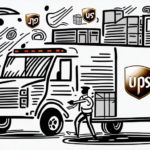How to Reduce Delivery Labor Fees in Your Supply Chain
As a business owner or manager, reducing expenses and increasing profits is always a top priority. One area that can often cause headaches and eat away at your bottom line is delivery labor fees in your supply chain. With the right strategies and tools, however, you can effectively manage and reduce these costs. In this article, we'll explore the various factors involved in delivery labor fees and provide practical tips for reducing them in your supply chain.
Understanding the Cost of Delivery Labor Fees in Your Supply Chain
Before jumping into solutions for reducing delivery labor fees, it's important to understand what exactly those fees entail. Delivery labor fees are typically associated with the costs of hiring, training, and managing workers involved in the transportation of goods within your supply chain. This may include fees for drivers, assistants, loaders, and other support staff.
Several factors determine the total amount of delivery labor fees in your supply chain, including the size and complexity of your operation, the number of shipments you handle, and the distances involved in delivery. Assessing these factors carefully can help identify potential areas for improvement and cost savings.
One significant factor impacting delivery labor fees is the level of automation in your supply chain. Automated systems can reduce the need for manual labor, leading to lower costs. Investing in technology such as GPS tracking and route optimization software can streamline delivery processes and decrease the time and resources required for each shipment.
Another important consideration is the quality of your workforce. Hiring and retaining skilled and experienced workers can improve efficiency and reduce errors, ultimately lowering labor costs. Providing ongoing training and development opportunities ensures that your workforce is equipped with the necessary skills and knowledge to perform their jobs effectively.
Analyzing Your Current Delivery Labor Costs
The next step in reducing delivery labor fees is to conduct a thorough analysis of your current costs. This may involve conducting a detailed audit of your supply chain operations to identify where labor costs are concentrated and which areas could be streamlined or optimized.
- Driver Pay Rates: Evaluate if your compensation aligns with industry standards.
- Overtime Rates: Monitor overtime to prevent excessive labor costs.
- Average Delivery Times: Shorter delivery times can reduce labor hours.
- Fuel Costs: Efficient routes can lead to significant savings.
By gathering and analyzing this data, you'll gain a clearer picture of your delivery labor fees and potential cost-saving opportunities.
Additionally, consider the type of delivery vehicles being used. Larger vehicles may require more labor to operate and maintain, while smaller vehicles might be more efficient but limited in load capacity. Evaluating the size and capacity of your delivery fleet ensures you're using the most cost-effective vehicles for your needs.
It's also crucial to stay informed about future trends and potential changes in the industry. For instance, advancements in technology may introduce more efficient delivery methods, such as drones or autonomous vehicles. Keeping up-to-date with industry developments and adapting your operations accordingly can help you stay ahead and reduce delivery labor costs in the long run.
Strategies for Reducing Delivery Labor Fees in Your Supply Chain
With a better understanding of the factors involved in delivery labor fees and your current costs, you can begin exploring various strategies to reduce those costs. Below are some practical tips to consider:
Investing in Technology to Streamline Your Supply Chain
One key strategy for reducing delivery labor fees is to invest in technology that can automate and streamline your supply chain operations. This may include:
- Route Optimization Software: Minimizes delivery times and maximizes efficiency.
- GPS Tracking: Monitors driver progress in real-time.
- Inventory Management Systems: Reduces wasted time and labor by optimizing stock levels.
According to a Supply Chain Digital report, businesses that implement route optimization can reduce fuel consumption by up to 20%.
Implementing Lean Principles in Your Supply Chain Operations
Incorporating lean principles involves identifying and eliminating waste, reducing unnecessary movement and transportation, and improving overall efficiency and productivity. This can lead to significant reductions in delivery labor costs.
Collaborating with Suppliers to Reduce Delivery Labor Fees
Working closely with your suppliers can help reduce delivery labor fees. Establishing closer relationships and collaborating on logistics processes and schedules may lead to reduced transportation costs and delivery times.
Outsourcing Delivery Labor to Third-Party Logistics Providers
Outsourcing your delivery labor needs to third-party logistics providers (3PLs) can be an effective strategy for reducing costs. These providers specialize in managing transportation and logistics services, optimizing your supply chain operations, and lowering overall labor fees.
Considering Alternative Modes of Transportation to Reduce Costs
Exploring alternative modes of transportation, such as rail or sea freight, can help reduce delivery labor fees. While these options may have longer lead times compared to traditional trucking, they can lower overall transportation costs significantly.
Conducting Regular Audits to Identify and Address Inefficiencies in Your Supply Chain
Regularly auditing your supply chain operations is essential for reducing delivery labor costs. Analyzing your data to identify inefficiencies and implementing solutions can lead to more streamlined and cost-effective operations.
Negotiating Better Contracts with Carriers and Freight Companies
Negotiating better contracts with carriers and freight companies can help lower your delivery labor fees. Leveraging your purchasing power and establishing long-term relationships may allow you to secure lower rates and more favorable terms.
Implementing Employee Training Programs to Improve Efficiency
Investing in employee training programs can reduce delivery labor fees by enhancing the efficiency and effectiveness of your workforce. Providing necessary skills and knowledge minimizes wasted time and labor, improving overall productivity.
Using Data Analytics to Optimize Your Supply Chain Operations
Data analytics is a valuable tool for reducing delivery labor fees. By analyzing data, you can identify trends and patterns that help optimize supply chain operations, reduce inefficiencies, and improve overall performance. Tools like Tableau and Microsoft Power BI can assist in visualizing and interpreting your data effectively.
The Importance of Continuous Improvement in Managing Delivery Labor Fees
Reducing delivery labor fees in your supply chain is not a one-time task but an ongoing process. Continuously assessing and refining your operations to identify new opportunities for optimization and cost reduction is essential.
Investing in technology that streamlines operations, such as route optimization software, can reduce delivery times and labor costs. Additionally, using data analytics to track delivery performance helps identify areas for improvement, leading to more efficient and cost-effective operations.
Prioritizing employee training and development is another critical aspect of continuous improvement. Providing ongoing training and support helps employees become more skilled and efficient, leading to better performance and reduced labor costs. Cultivating a culture of continuous improvement encourages employees to identify and suggest new ways to optimize operations and reduce costs.
Measuring the Success of Your Efforts in Reducing Delivery Labor Fees
Measuring the success of your efforts to reduce delivery labor fees is crucial. This involves tracking key performance indicators (KPIs) such as delivery times and costs, customer satisfaction, and employee morale.
One effective method is conducting regular surveys with your customers to understand their satisfaction levels with your delivery service and identify areas for improvement. Additionally, analyzing your delivery data can help identify trends or patterns that may impact your labor fees.
Consider the training and development of your delivery staff as well. Investing in their skills and knowledge improves their efficiency and effectiveness, leading to lower labor fees. Regular performance evaluations and feedback sessions help identify areas for improvement and ensure that your staff meet delivery targets.
Common Mistakes to Avoid When Trying to Cut Delivery Labor Costs
While reducing delivery labor fees can be challenging, it's important to avoid common mistakes that can undermine your efforts:
- Underestimating Transportation Impact: Failing to recognize how transportation affects overall supply chain costs.
- Inaccurate Tracking of Labor Costs: Not maintaining precise records can lead to overspending.
- Insufficient Investment in Technology: Neglecting technology and process improvement initiatives can hinder cost reduction efforts.
- Poor Training of Delivery Personnel: Without proper training, employees may be inefficient, leading to longer delivery times and increased labor costs.
- Lack of Clear Communication: Ineffective communication plans can cause confusion and errors, further increasing costs.
- Ignoring External Factors: Failing to plan for external factors like weather and traffic can result in unexpected delays and higher labor fees.
By avoiding these mistakes and implementing effective strategies, businesses can better control their delivery labor costs.
Conclusion: Taking Action to Improve Your Supply Chain's Bottom Line
Reducing delivery labor fees in your supply chain requires a strategic approach that incorporates data analysis, technology investment, and process optimization. By identifying areas for improvement and implementing proven solutions, you can effectively manage your delivery labor costs and enhance your supply chain's bottom line.
One effective solution is implementing automated systems for order fulfillment and tracking. This can include using robotics and artificial intelligence to streamline the picking and packing process, as well as utilizing real-time tracking technology to optimize delivery routes and reduce transportation costs. For more information, visit our Automation Solutions page.
Employee training and development play a crucial role in reducing delivery labor fees. Investing in ongoing training programs and providing opportunities for career advancement improves employee retention and productivity, leading to a more efficient and cost-effective supply chain. Learn more about our Training Programs.




















